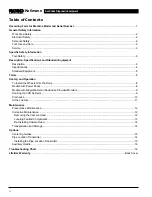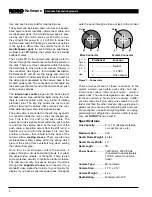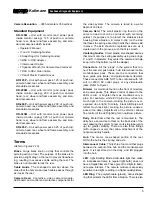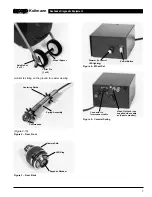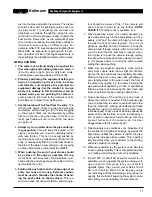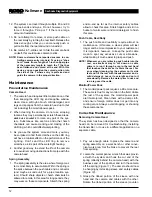
4. Do not overreach. Keep proper footing and bal-
ance at all times. Proper footing and balance
enables better control of the tool in unexpected sit-
uations.
5. Use safety equipment. Always wear eye protec-
tion. Dust mask, non-skid safety shoes, hard hat,
or hearing protection must be used for appropriate
conditions.
Tool Use and Care
1. Do not use tool if switch does not turn it ON or
OFF. Any tool that cannot be controlled with the
switch is dangerous and must be repaired.
2. Store idle tools out of the reach of children and
other untrained persons. Tools are dangerous in
the hands of untrained users.
3. Maintain tools with care. Properly maintained
tools are less likely to cause injury.
4. Check for breakage of parts, and any other con-
dition that may affect the tools operation. If dam-
aged, have the tool serviced before using. Many
accidents are caused by poorly maintained tools.
5. Use only accessories that are recommended by
the manufacturer for your model. Accessories
that may be suitable for one tool may become haz-
ardous when used on another tool.
6. Inspect tool and extension cords periodically
and replace if damaged. Damaged cords increase
the risk of electrical shock.
7. Keep handles dry and clean; free from oil and
grease. Allows for better control of the tool.
8. Store tools in dry place. Such measures reduce
the risk of electrical shock.
Service
1. Tool service must be performed only by quali-
fied repair personnel. Service or maintenance
performed by unqualified repair personnel could
result in injury.
2. When servicing a tool, use only identical
replacement parts. Follow instructions in the
Maintenance Section of this manual. Use of
unauthorized parts or failure to follow maintenance
instructions may create a risk of electrical shock or
injury.
3. Follow instructions for lubricating and chang-
ing accessories. Accidents are caused by poorly
maintained tools.
Specific Safety Information
The Operator’s Manual contains specific safety infor-
mation and instructions for your protection against
serious injuries including:
• Electrical shock or burns from contact with wires
or other electrical parts.
Read and follow the safety labels on machine!
Know the location and functions
of all controls before using system.
Tool Safety
1. Before using, test the Ground Fault Circuit
Interrupter (GFCI) provided with the power cord
to ensure it is operating correctly. GFCI reduces
the risk of electrical shock.
2. Extension cords are not recommended unless
they are plugged into a ground fault circuit inter-
rupter (GFCI) found in circuit boxes or recepta-
cles. The GFCI on the monitor power cord will not
prevent electrical shock from the extension cords.
3. Do not operate the system with electrical enclo-
sures removed. Exposure to internal parts
increases the risk of injury.
4. Do not place the monitor and power pack in
water or on a wet surface. Water entering the
housings will increase the risk of electrical shock.
5. Do not use the monitor as a chair or table. Do
not drop or shock the monitor. Can result in
damage to the unit which increases the risk of elec-
trical shock.
SAVE THESE INSTRUCTIONS!
Description, Specifications,
and Standard Equipment
Description
The RIDGID/Kollmann patent pending SeeSnake Pipe
Inspection Tool is ideal for inspecting 2
″
to 10
″
drain
lines. Its flexible camera head can negotiate multiple
hard 90° bends, and the fiberglass rod is flexible
enough to easily travel bends, yet stiff enough to push
the camera head over 300
′
. The hardened stainless
steel camera housing, sapphire crystal lens port (a
material which doesn’t scratch), waterproof connec-
SeeSnake Diagnostic Equipment
Kollmann
3


